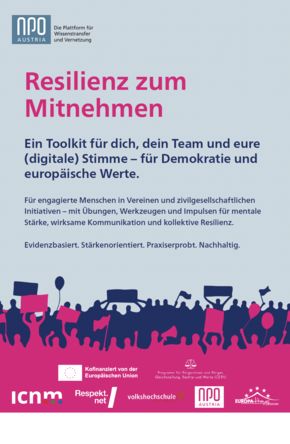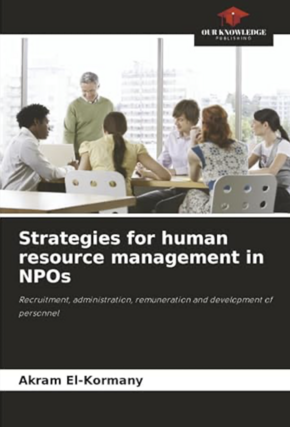Publikationen
Inhalt dieses Kapitels
- npoAustria | Resilienz zum Mitnehmen
- Westbrook, T. R.; Holmes A. K. | Data Party: You Can Transform Your Nonprofit Organization with Data (2026)
- Lafleur, S. | The Myth of Non-Profit Success (2025)
- El-Kormani, A. | Strategies for human resource management in NPOs (2025)
npoAustria | Resilienz zum Mitnehmen
Wir freuen uns, mitteilen zu dürfen, dass unser Resilienz-Toolkit für Advocacy-Akteur:innen im Oktober auf unserer Website veröffentlicht wurde. Das Toolkit entstand im Rahmen des EU-Projektes ProEuropeanValuesAT und wurde durch das EU-Programm CERV gefördert. Es steht sowohl digital als auch als Broschüre zur Verfügung.
Unter dem Titel „Resilienz zum Mitnehmen – Ein Toolkit für dich, dein Team und eure (digitale) Stimme – für Demokratie und europäische Werte“ dient es als praktisches Nachschlagewerk – für Sie persönlich und gemeinsam mit Ihrem Team, um Wissen zu Resilienz und (digitaler) Advocacy-Arbeit zu vertiefen oder aufzufrischen. Entdecken Sie das Toolkit und nutzen Sie wertvolle Impulse für sich und Ihr Team!
Alle Materialien finden Sie auf der Website von npoAustria:
short.wu.ac.at/Resilienz-zum-Mitnehmen.
Westbrook, T. R.; Holmes A. K. | Data Party: You Can Transform Your Nonprofit Organization with Data (2026)
A practical guide to making data capacity accessible, meaningful, and empowering in nonprofits.
Publisher: Johns Hopkins University Press
Publishing Date: April 28, 2026
ISBN-13: 978-1421453026
In today's nonprofit landscape, the language of data is everywhere. Leaders are urged to be data-driven, but for many small and mid-sized organizations, the idea of working with data is as intimidating as it is essential. Some feel overwhelmed by the demand to build reliable systems for reporting and analysis, while others are buried under numbers they cannot organize into meaningful insights. In Data Party, T'Pring R. Westbrook and Allison K. Holmes bring fresh perspective to what it means for nonprofits to strengthen their data capacity.
Data Party speaks directly to leaders, staff, and partners navigating the complexities of today's information-oriented environment. It provides a language and framework that make data capacity approachable while never losing sight of the broader values that drive nonprofit missions. For anyone invested in using information to make better decisions and deepen community impact, this book is an invaluable resource.
Lafleur, S. | The Myth of Non-Profit Success (2025)
An In-Depth Analysis of Haiti's Development Efforts (Kindle Edition)
Publisher: Choublak Publishing
Publishing Date: November 3, 2025
ISBN-13: 978-9699592645
The Myth of Non-Profit Success by Sem Lafleur is a powerful and deeply researched examination of Haiti’s development landscape and the complex role of international aid and non-profit organizations. The book challenges prevailing narratives about success in humanitarian and development work.
It exposes how well-intentioned interventions often perpetuate dependency rather than empowering local resilience. This happens through historical analysis, case studies, and on-the-ground insights. Lafleur traces how Haiti’s reliance on foreign aid has evolved from colonial exploitation to modern dependency. The author reveals that despite billions of dollars in assistance—especially after the 2010 earthquake—much of this support failed to create lasting change, often because projects were externally driven, poorly coordinated, and detached from the realities of Haitian life.
El-Kormani, A. | Strategies for human resource management in NPOs (2025)
Recruitment, administration, remuneration and development of personnel
Publisher: Our Knowledge Publishing
Publishing Date: July 23, 2025
ISBN-13: 978-6200738257
Human resources are among the most important resources of an organisation, as without personnel, the tasks within the organisation cannot be fulfilled. However, this is not only the case for profit-oriented organisations, but also for non-profit organisations. In order to manage this scarce resource in organisations, whether profit or non-profit, a well-thought-out management plan for human resources must be considered. This paper provides an overview of human resource management in general and human resource management in NPOs in particular. It explains the basics of human resource management and highlights the differences between human resource management in profit and non-profit organisations. Furthermore, certain points are raised on how non-profit organisations should proceed when managing human resources in order to recruit, administer, remunerate and develop their staff. Finally, a youth organisation in Austria is used to illustrate how it handles its specific approach to human resource management.





